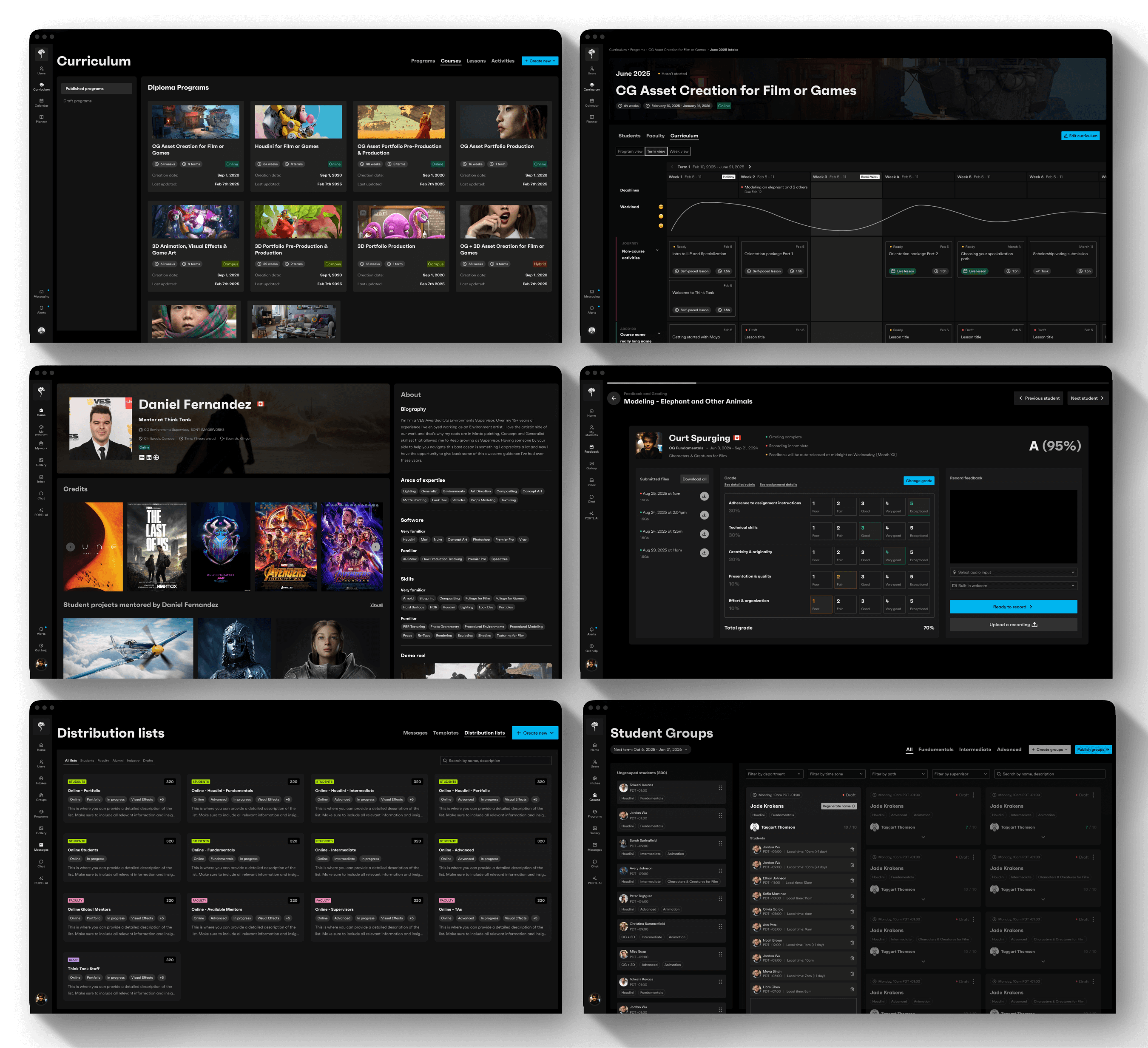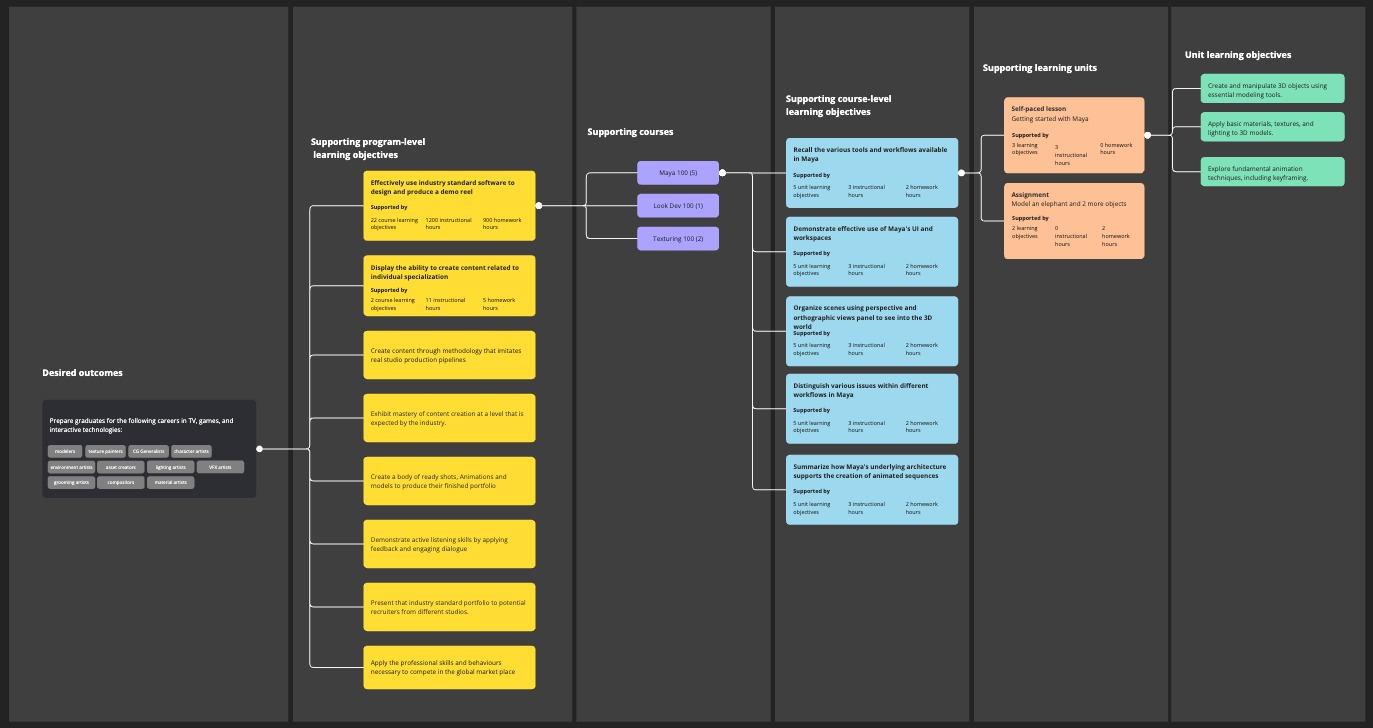
Head of Product and CX
Think Tank Training Centre
Nov 2024 - current
Education, AI, Higher ed, Online training, LMS, SIS, HRIS, ERP
Product Strategy
User Experience Design
Brand Management
GTM Strategy
Delivery
PORTL is the proprietary Learning Management System of Think Tank Training Centre, the #1 VFX and Game Development Institution Worldwide. Originally launched in 2017, its goal was to bring Think Tank’s campus experience online without compromising quality, mentorship, or hiring rates.
The first version had limitations (scalability, compliance, and user experience, among a few) but it successfully proved that a complex and technically demanding discipline like VFX could be taught effectively online. Development of PORTL 2.0 began in 2021 to address those gaps and prepare the system for long-term growth.
I was brought in to take this promising but stalled project to completion within 16 months, retire the legacy system, and prepare it for SaaS commercialization.
My dual mandate:

Working with limited resources, a small cross-functional team, and a tight timeline, I took ownership of the entire product lifecycle - from vision to delivery. Reporting directly to the CEO, I defined product and design strategy, re-architected the data model, managed integrations across CRM, accounting, and marketing systems, and established a roadmap tying LMS, SIS, HRIS, and ERP capabilities into one coherent ecosystem.
While each of these areas could be its own case study, the following sections focus on the vision and innovation that are defining how PORTL is set up to reshape education technology.
When I accepted this role, I knew how saturated and competitive ed tech market is. From higher-ed systems like Brightspace and Canvas, to corporate platforms such as Absorb and Classe365, dozens of products claim to deliver end-to-end academic solutions. However, they all share same unsolved problems:
- A focus on content delivery rather than student outcomes
- Fragmented systems and data, with no persistence across CRM, SIS, LMS, HRIS and ERP layers
- Limited scalability for mentorship-driven or vocational programs
- Ongoing compliance and accreditation challenges
- Poor visibility into student performac, feedback, and employability data
- High administrative and IT overhead and inefficiency
- Clunky UX and disjointed brand experiences
Based on the comprehensive market analysis, our own internal data of PORTL 1.0 usage, and three years worth of product discovery sessions, story maps, usability testing, and interviews, we distilled our value proposition into a clear vision:

This vision was supported by two primary success metrics:
1. Operational efficiency: eliminate redundant tasks across all user roles so students, faculty and admins can focus on education, and not tech
2. Student employability: learning journey should always end in a successful career
Over the last decade, the rise of shared design systems, templates, and patterns has led to homogenization of digital products - they've started to blur together; same layouts, same visuals, same promises of "AI-driven intelligence". So our challenge wasn't to build another platform that looks modern; it was creating one that genuinely advances how people learn, teach, and work.
PORTL does that through four core differentiators: a bold and unique brand, a seamless and intuitive user experience, best teaching practices built directly into the product, and adaptive AI at the core of every interaction.

The name PORTL is a stylized take on portal - a threshold, a passage, an entry point. In mythology and science fiction, portals connect the familiar with the unknown. In education, they represent access: to knowledge, mentors, tools, and new ways of thinking.
PORTL’s brand is deeply tied to Think Tank’s 20-year legacy as the world’s top-ranked VFX and 3D school. It inherits the school’s reputation for excellence and creativity, translating it into a digital experience that feels both grounding and distinct.
At its core, PORTL represents a transition point - the moment a learner steps forward into growth. In digital design, a portal is also where everything begins - a unified interface that connects people, data, and opportunities. PORTL embodies that principle: it isn’t the destination, but the launchpad for learning, teaching, and transformation.

We established core UX principles that dictated how we approached every product idea:

JTBD, not personas
Focusing on what users are trying to accomplish rather than who they are is key to increasing product-market fit. While personas capture demographics and motivations, they often fail to address situational intent and the "why now?" behind user behaviour. By designing around jobs (e.g. "I need to give feedback faster", "I need to see which student is struggling"), we prioritized context and user's goals, not who they are.
Right information, at the right time, on the surface
Users shouldn't have to dig through tables and dashboards to find information. By using JTBD, we built a system that anticipates needs based on role, activity, and timing, surfacing alerts, smart actions, and insights contextually and exactly when they are needed.
Always optimize for student success
Every design decision was filtered through one question: “Does this help the student succeed?” That includes visibility into progress, access to mentorship, and clarity in feedback loops. We intentionally shifted the UX hierarchy away from content delivery towards learning outcomes.
Make everyone's job 60% more efficient
Every user group (student, faculty, admin) performs dozens of repetitive, manual actions daily. By automating predictable workflows and simplifying interactions (e.g., feedback, scheduling, reporting), we set a measurable efficiency target: reduce manual effort by 60% across key tasks.

PORTL’s curriculum design system is grounded in experiential learning, a model proven to improve long-term knowledge retention by 60–75% compared to lecture-based instruction. The Curriculum Builder follows a learning-outcomes-first approach, where outcomes defined at the lesson level cascade upward to course and program levels. This structure ensures consistency, measurable progress, and alignment between what’s taught and what students are expected to achieve. Sessions are designed to support experiential learning cycles, combining asynchronous lessons, live mentor check-ins, projects, and peer feedback in one flow. Faculty can mix components like Do–Reflect–Conceptualize–Apply to promote active learning and skill transfer.
Faculty tools also reinforce teaching best practices by prompting activity types that align with learning outcomes and tracking their impact on student success. Because outcomes are embedded at every level, PORTL provides data on teaching effectiveness and program performance, enabling continuous improvement and compliance readiness.

Rewind back to your time when you were a student. Imagine being able to ask questions like “What are my gaps?”, “What materials should I revisit?”, “How to best plan my upcoming week?”. Using RAG architecture, we are able to feed all personal student data - from their learning behaviour to assignment feedback and mentorship call transcripts - to PORTL AI to create a truly personalized learning assistant that adapts to students’ specific daily goals from day 1 to graduation.
For faculty, PORTL AI adapts to make their job faster (e.g. a curriculum summary of upcoming week) to predictive risk mitigation strategies for students who struggle.
For admins, PORTL AI is the intelligence engine that surfaces critical time-sensitive information, identifies revenue risks and opportunities, and, most importantly, identifies gaps or inconsistencies in curriculum, benchmarking against job market requirements and employment outcomes.

Over the past 12 months, PORTL 2.0 has evolved into a fully integrated platform supporting the core jobs of students, faculty, and administrators. The system now underpins Think Tank’s academic and operational workflows and is positioned to replace the legacy PORTL 1.0 infrastructure.
We’ve designed and delivered a broad feature set covering all critical user needs — from student learning and feedback to faculty mentorship and institutional oversight. Each module is interconnected, ensuring data consistency, operational transparency, and a single source of truth across the school.
In August 2025, we announced the launch of PORTL 2.0 at SIGGRAPH, marking a major milestone in its development and public debut. The team has since finalized the roadmap for external deployment, with a beta version planned for vocational schools in 2026 and the capability to onboard the first external customer by Q3 2026.
The platform is now entering its final implementation phase, with full rollout and legacy system retirement scheduled for February 2026.